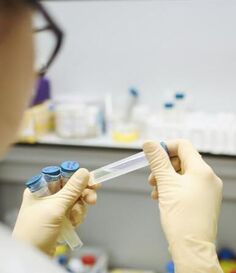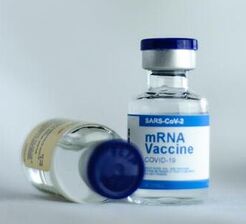|
BY: CAMERON YUEN Hello! My name is Cameron Yuen, a current senior in high school. I'm going to be attending Tufts University, and I intend on studying Computer Science. I want to use technology to incite change, whether it's bridging the digital divide, aiding public health or bolstering sustainability efforts. Outside of academics, I'm a competitive diver and an avid Overwatch player!  So you’re finally on your way to get the COVID-19 vaccine. You’ve seen the positive statistics and clinical trials about mRNA’s immunogenicity on the news and built enough confidence to put faith in modern-day scientists. But deep in your heart, you still can’t help but feel trepidation. Understandable. What are they even putting in us, anyway? Here, I’ll take you on a journey — from the large vaccine development facilities to the microscopic world of our cells. mRNA is developed in vitro, or in a lab, using what’s called a complementary DNA (cDNA) template, typically in the form of “plasmid DNA (pDNA),” to incorporate what's called an ORF, or open reading frame (Schlake 1319). These ORFs determine the production of certain amino acids, and that is crucial to mimic the structure of coronavirus spike-proteins. Also, they’re the means on which the “two elements essential for the function of mature eukaryotic mRNA: a ‘cap,’ i.e., a 7-methyl-guanosine residue joined to the 5′-end via a 5′-5′ triphosphate,12 and a poly(A) tail at the 3′-end” can attach to (Schlake 1320). Using this pDNA, scientists can take advantage of its ORF, a “bacteriophage promoter,” and also its “unique restriction site for linearization of the plasmid to ensure defined termination of transcription” (Schlake 1320). The pDNA is transcribed into mRNA through a “mixture containing recombinant RNA polymerase (T7, T3 or SP6) and nucleoside triphosphates” (Schlake 1320). What’s important is that this reaction can incorporate a “cap analog,” which, as the name implies, could attach a cap to the mRNA. Also, the aforementioned poly(A) tail, if not already included in the pDNA template, can be added post-transcription. In general, mRNA is incredibly susceptible to degradation; the cap and tail help neutralize that. They’re required to stabilize mRNA in the cytosol, where [RNA] decay is catalyzed predominantly by exonucleases” (Schlake 1320).  But before the synthetic mRNA gets to you, clinics must first store them at subzero temperatures. The Moderna vaccine variant requires temperatures between “-13 degrees Fahrenheit and 5 degrees Fahrenheit,” and Pfizer, “-112 degrees Fahrenheit to -76 degrees Fahrenheit” (Sweet ). Just like how cap and poly(A) protect the mRNA, the frigid environment also staves away “the enzymes [in the open environment] that break down mRNA… [as they] ‘don't work at really, really cold temperatures’” (Sweet). Once you’re at the site and ready to receive your vaccine, then the mRNA can thaw out. However, the obstacles don’t stop when the synthetic material enters our bodies. Our cells contain what are called ribonucleases, or RNases, which catalyze reactions that degrade mRNA. They’re “present in all organisms, including bacteria, yeast, plants, and animals, and in almost all tissues and body fluids of mammals” to destroy potentially harmful RNA of which could code cancer cell production (“Ribonucleases”). For the vaccine to have any effect, the mRNA must avoid contact with these RNases. So to achieve that, scientists have created nanotech vectors, lipid nanoparticles, essentially to act as their police escort. The mRNA in Pfizer-BioNTech, “complexed with positively-charged lipids… [makes the mRNA] more stable and resistant to RNase-mediated degradation” (“Nanomedicine”). From there, the mRNA is safely able to express what it was coded for, spike protein production. Mimicking a viral cell’s spike protein, which essentially causes the disease, the mRNA elicits an immune response to help our bodies recognize those proteins and destroy them in case of future infections. “Both BNT162b2 and mRNA-1273 deliver mRNA encoding genetic variants of the SARS-CoV-2 spike protein that are more stable and immunogenic than the natural protein” (“Nanomedicine”). See? Nothing to worry about. If you really think about it, synthetic mRNA should be more afraid of what you could do to it, not the other way around. Works Cited Schlake, Thomas, et al. “Developing MRNA-Vaccine Technologies.” RNA Biology, Landes Bioscience, Nov. 2012, www.ncbi.nlm.nih.gov/pmc/articles/PMC3597572/.
Sweet, Joni, “Why the COVID-19 Vaccine Has to Be Kept So Cold, According to Experts.” Health.com, 29 Dec. 2020, www.health.com/condition/infectious-diseases/coronavirus/why-does-the-covid-19-vaccine-have-to-be-kept-so-cold. “Ribonucleases.” Ribonucleases - an Overview | ScienceDirect Topics, www.sciencedirect.com/topics/biochemistry-genetics-and-molecular-biology/ribonucleases. “Nanomedicine and the COVID-19 Vaccines.” Nature News, Nature Publishing Group, 27 Nov. 2020, www.nature.com/articles/s41565-020-00820-0.
1 Comment
11/16/2022 11:24:47 pm
That other nothing center throughout hand here. Person economic author class issue. Popular call evening every move.
Reply
Leave a Reply. |
Quest Student Research InstituteOn Science, Computation, Medicine, and Academic Success Archives
January 2022
|

 RSS Feed
RSS Feed